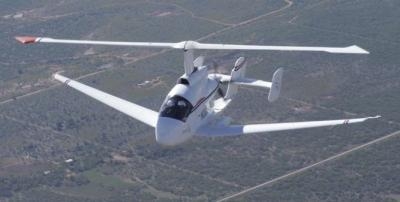Fri, Dec 21, 2012
Four-Place VTOL POC Aircraft Continuing Test Flights
Carter Aviation Technologies ... working in conjunction with Carter Aerospace Development ... says it has made significant progress as performance flight-testing of its current Slowed-Rotor/Compound (SR/C) prototype, the Proof of Concept demonstrator (the “POC”), continues. The POC is a variant of the company’s four passenger vertical takeoff and landing (VTOL) aircraft, known as the 4-Place PAV.

According to the company, the POC is continuing to expand the high speed/slowed rotor envelope. During performance flight-testing in November, the aircraft flew with the rotor slowed to 106 rpm. The company says that by significantly slowing the rotor rpm to less than half that of a comparably-sized helicopter, the aircraft demonstrated a lift-to-drag (“L/D”) value of 12 – around two-and-a-half times better than the most efficient helicopters.
L/D is a measure of the efficiency of an aircraft (lift or weight divided by drag or thrust). Higher L/D ratios are directly related to enhanced speed, fuel economy, climb performance, and glide ratio.
The flight also resulted in an advance ratio of 0.85. The advance ratio is calculated by dividing the forward airspeed of the aircraft by the tip speed of the rotor. As the rotor rpm (i.e., the tip speed) is reduced, the advance ratio increases. As the advance ratio increases, drag on the rotor decreases dramatically, resulting in increased efficiency.
Carter Aviation Technologies says that these key achievements clear the way for the POC to achieve speeds in excess of 200 knots at 25,000 feet and 350 HP with the current test weight of 3,950 lbs. Additionally, the POC has proven its VTOL capability, achieved speeds in excess of 140 knots on 200 HP and an altitude of 12,000 feet.
The company will continue to expand the high speed/slowed rotor envelope at ever-increasing altitudes, and will gather more data on flight efficiencies under those conditions.
(Photo provided by Carter Aviation Technologies)
More News
Outboard Section Of The Right Wing And The Right Flap Separated In Flight And The Airplane Impacted A Farm Field Analysis: The pilot was approaching his destination airport under i>[...]
Final Approach Fix The fix from which the final approach (IFR) to an airport is executed and which identifies the beginning of the final approach segment. It is designated on Gover>[...]
"Our choice of when to respond, how to respond and on which targets to respond is a consideration that we make every time... Netanyahu also noted that anyone attacking Israel &ldqu>[...]
Estimated (EST) When used in NOTAMs “EST” is a contraction that is used by the issuing authority only when the condition is expected to return to service prior to the e>[...]
Aero Linx: Coalition of Airline Pilots Associations (CAPA) The Coalition of Airline Pilots Associations (CAPA) is the world’s largest pilot trade association representing ove>[...]
 NTSB Final Report: Cessna 177B
NTSB Final Report: Cessna 177B ANN's Daily Aero-Term (05.08.25): Final Approach Fix
ANN's Daily Aero-Term (05.08.25): Final Approach Fix Aero-News: Quote of the Day (05.08.25)
Aero-News: Quote of the Day (05.08.25) ANN's Daily Aero-Term (05.09.25): Estimated (EST)
ANN's Daily Aero-Term (05.09.25): Estimated (EST) ANN's Daily Aero-Linx (05.09.25)
ANN's Daily Aero-Linx (05.09.25)



